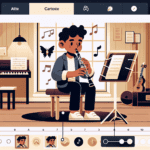Teaching the clarinet blends technical instruction with fostering creativity and expression. Effective clarinet teaching methods vary for each student. Whether you're experienced or new to teaching, focusing on enjoyable and accessible learning leads to success. The classic Martin Freres Clarinets often inspire teachers with their dedication to craftsmanship and music education.
Start with the Fundamentals: Building a Solid Foundation
Every clarinet student brings unique experiences and strengths. That's why starting with the basics is crucial. From perfecting embouchure to mastering finger positions, these foundational skills are essential. Embouchure training can be challenging but is vital. While teaching proper lip and tongue shape, it's also important to emphasize relaxation. Tension is the enemy of good technique!
Proper breathing techniques are equally important. Have your students practice controlled breathing exercises often. For younger players, try the balloon exercise to help them visualize filling their diaphragm and slowly exhaling while playing. It's a practical way to make this subtle aspect of performance more understandable!
| Fundamental Skill | Key Focus Areas | Practice Tips |
|---|---|---|
| Embouchure | Lip shape, tongue position, relaxation | Mirror exercises, long tones |
| Breathing | Diaphragm control, air support | Balloon exercise, breathing games |
| Finger Placement | Correct positioning, dexterity | Slow scales, finger exercises |
Focus on Finger Placement and Dexterity
Don't overlook the importance of finger technique! Fast passages require quick, precise finger movements. Start by teaching finger exercises slowly, then gradually increase speed to build muscle memory without compromising accuracy. Introduce scale practice early, but keep it interesting with minor and chromatic scales to prevent boredom during practice. The connection between fingers and clarinet keys becomes second nature with consistent practice.
Creative Repertoire Choices
Spice up your lessons with diverse repertoire! Mix classic pieces like Mozart's Concerto in A Major with lesser-known or contemporary selections to keep teaching engaging. Try fun duets or explore music from different cultures to broaden students' musical horizons. Arranging popular songs or movie themes for clarinet can make practice more appealing for reluctant learners.
Referencing respected brands like Martin Freres Clarinets during lessons can motivate students. Understanding the craftsmanship behind quality instruments gives students goals to work towards, whether they're upgrading their instrument or dreaming of future possibilities.
Integrate Group Lessons for Skill-Sharing
Music thrives in community settings. Encourage collaboration through small ensemble work. Clarinet choirs are excellent for teaching teamwork and interpretation. As students listen and play together, they develop skills in balance, timing, and cooperation—all essential for ensemble performance. Group lessons also add a social element that can boost enthusiasm!
Tailor Approaches to Each Learner
Different students learn in different ways. Some respond well to visual aids like fingering charts or embouchure diagrams, while others learn best through hands-on practice or listening. Pay attention to individual learning styles to improve your teaching effectiveness.
I once taught a student who struggled with rhythm until we started clapping patterns together and assigning simple words to each note. This approach worked wonders for her! Remember, flexible teaching methods can make clarinet lessons more engaging and effective.
Encourage Progress with Positive Reinforcement
Students of all ages respond well to encouragement. Celebrate small achievements, whether it's hitting a high note or mastering dynamics in a piece. Every bit of praise motivates your student to keep improving. Consider recording practice sessions occasionally to give students a chance to hear their own progress.
Maintain the Instrument as Part of the Lessons
A well-maintained instrument is crucial for good playing. Teach simple maintenance tips during lessons, such as swabbing the bore after playing and properly greasing corks. Share stories about the consequences of neglecting instrument care to help students understand its importance. When students see how proper care affects their playing, they develop respect for their instrument.
While we're not focusing on specific brands, understanding the quality of instruments like Martin Freres helps students appreciate how a well-maintained clarinet improves their playing experience.
Cross-Train with Related Skills
Improving musical ability isn't just about playing the clarinet. Incorporate movement exercises, rhythm games, or music theory to enhance overall musicianship. Try having students dance to a metronome while focusing on breath control—it might seem unusual, but it can be very effective! These varied activities can help shy students become more confident performers.
Plan Regular Performance Opportunities
While stage fright is common, regular performances help students feel more at ease. Organize small recitals for friends and family to help students get comfortable playing for an audience. With practice, students learn that musicality improves under the excitement of performance.
Constantly Grow Your Educator Self
As a clarinet teacher, always seek opportunities to learn and improve. Attend workshops focused on woodwind instruction, and exchange ideas with fellow clarinetists. Personal experimentation and practice can lead to valuable insights that enhance your teaching.
Table of Contents
- Start with the Fundamentals: Building a Solid Foundation
- Focus on Finger Placement and Dexterity
- Creative Repertoire Choices
- Integrate Group Lessons for Skill-Sharing
- Tailor Approaches to Each Learner
- Encourage Progress with Positive Reinforcement
- Maintain the Instrument as Part of the Lessons
- Cross-Train with Related Skills
- Plan Regular Performance Opportunities
- Constantly Grow Your Educator Self







